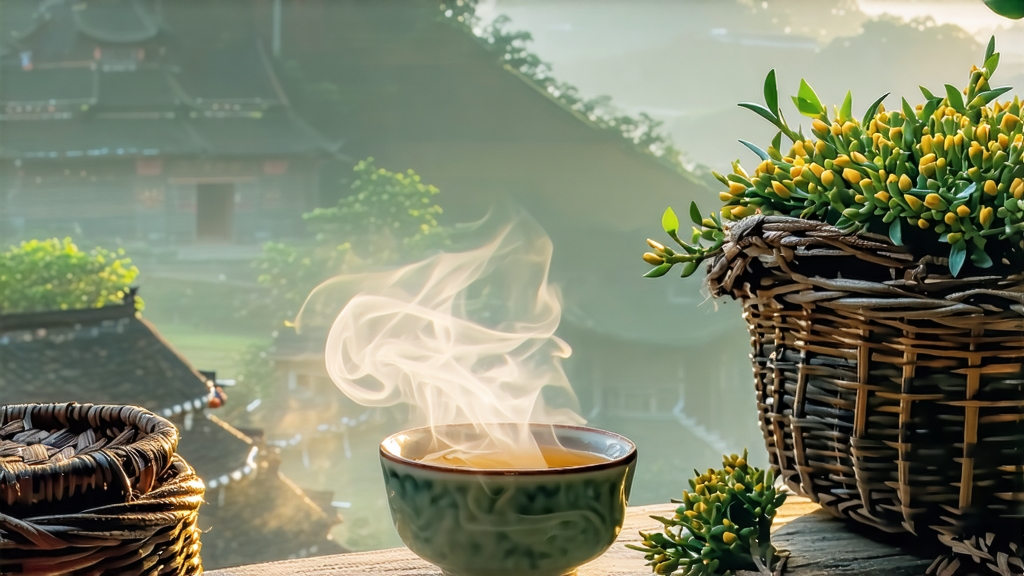
Tucked high on the northern rim of the Sichuan Basin, where the Min River elbows through perpetual cloud, lies Meng Ding Mountain—Meng Shan to locals. At roughly 1,450 m above sea level, the peak traps moist monsoon air, birthing a cool, fog-draped microclimate that tea bushes adore. It was here, during the Tang dynasty (618-907 CE), that Buddhist monks first coaxed a tiny, jade-green bud into a tea so refined that emperors would later claim every leaf as tribute. That tea is Meng Ding Huang Ya—Meng Ding Yellow Bud—an aristocrat among China’s rare yellow teas, now almost invisible on the world market yet still whispered about in the same breath as Junshan Yin Zhen and Huo Shan Huang Da Cha.
Historical scrolls kept in the mountain’s Gan-Dong temple record that by 724 CE the “Yellow Bud” already graced the imperial table. A Song-era edict (1083 CE) fixed the annual picking window at Qing Ming—roughly 5 April—when only the unopened bud, sheathed in pale down, was deemed worthy. Caravans of porters carried the harvest 1,400 km to Chang’an, timing arrival for the emperor’s birthday banquet. Such privilege bred secrecy; even local farmers spoke of the tea in euphemism, calling it “cloud seed” or “immortal tip.” When tribute systems collapsed after 1911, production stopped. Bushes grew wild for decades until 1954, when a state delegation retraced ancient maps and re-grafted surviving mother plants. Today fewer than 300 mu (20 ha) of certified gardens remain, yielding perhaps 1.2 tonnes a year—less than a single morning’s output of a modern green-tea factory.
Meng Ding Huang Ya is a bud-centric tea, plucked one leaf and a half-inch bud, or occasionally just the bud itself. Pickers climb terraces before dawn so that dew keeps cells turgid; any wilting in sunlight oxidises edges, ruining the signature “yellow” later. Leaves rest in shallow bamboo trays for four to six hours, losing roughly 10 % moisture—just enough to soften the blade for rolling without breaking surface hairs. The critical step, shared by all yellow teas, is sealed yellowing (men huang). After a 3-minute high-heat “kill-green” at 160 °C to fix colour, the still-warm leaves are piled 8 cm deep inside linen sacks and slid into a humid 28 °C room. Over the next 48 hours, residual enzymes nibble at chlorophyll, shifting hue from grassy green to pale champagne while converting harsh catechins into softer theaflavins. Every six hours a master opens the sacks, fluffs the pile, and checks aroma for the tell-tale shift from fresh pea to toasted chestnut. Finally, a low 60 °C bake for two hours halts chemistry, locking in a mellow sweetness that green tea can never attain.
The finished leaf is slim and slightly curved, the colour of old ivory with a faint celadon vein. When viewed under 10× magnification, each bud shows a downy cloak of trichomes—proof that only the plant’s most tender meristem was taken. Aroma in the bag is subdued: steamed rice, baked pumpkin skin, and a trace of Sichuan pepper orchards below the mountain. Yet the magic happens when water meets leaf.
Western brewers often treat yellow tea like a delicate green, using 70 °C water and brief steeps. While this avoids bitterness, it also leaves the tea’s soul unroused. Meng Ding Huang Ya prefers a bolder courtship. Start with 4 g of leaf in a 150 ml gaiwan. Rinse quickly with 85 °C water, discard, then infuse 20 s at the same temperature. The first liquor glows pale gold with a faint jade rim—what Chinese poets call “duck-yellow.” Aroma rises in layers: warm marzipan, then fresh corn milk, finally a cool camphor echo from surrounding fir forests. Sip, and the texture is glycerine-thick, sliding across the tongue like warm bone broth. Sweetness arrives late, blooming at the back of the throat and lingering for minutes. Second steep, lengthened to 30 s, adds white sesame and steamed custard notes. By the fifth infusion, colour fades to moonlight, yet a mineral sweetness—Meng Shan’s granite aquifer—